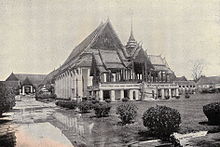Uparaja
Uparaja (also spelled Uparaj, Uparat, Ouparath; Thai : มหา อุปราช RTGS : Maha Uparat) was the position of a "second king" or " viceroy " in the Buddhist dynasties of Laos , Siam , Burma and Cambodia , as well as some tributary principalities.
Siam (Thailand)
The office of Phra Maha Uparat was first established in writing in the palace law of King Borommatrailokanat in the middle of the 15th century. This determined that the firstborn king's son would become Uparat. In addition, the laws on the civil and military hierarchy of the provinces of 1455, also passed by Borommatrailokanat, gave the Uparat a sakdina value of 100,000 rai . This gave him - after the king - the highest rank in the kingdom, far ahead of other princes, chief ministers or provincial princes. The Sakdina system was valid until the end of the 19th century.
During the reign of Borommatrailokanat the viceroy was particularly important, since the king resided in the "second capital" Phitsanulok from 1463 during the war between Ayutthaya and Lan Na , while he took the throne in the actual capital Ayutthaya to his son Borommaracha III. left. Later it was mostly the other way around: the king resided in Ayutthaya, his Uparat in Phitsanulok. In some cases the king's brother was appointed uparat instead of the son. For example in the case of King Naresuan (r. 1590–1605) and his deputy Ekathotsarot .
The exception later became the rule: In the 18th and 19th centuries, the Uparat was usually the king's brother. He was the heir to the throne after the king's death. If the uparat died before the king, his position was usually not filled until a new king and thus a new uparat was installed. The official title of the viceroy at this time was Krom Phra Ratchawang Bowon Sathan Mongkhon ( กรม พระราชวัง บวร สถาน มงคล ), colloquially both the office and the incumbent were metonymically named after the official seat of Wang Na ( วังหน้า , ie "Front Palace").
In the Kingdom of Ayutthaya , the Front Palace, the Chandra Kasem Palace , was in the northeast corner of the island. It was built in 1577; King Mongkut had it restored and converted into his summer palace. Today it houses the "Chantharakasem National Museum".
In the Rattanakosin period (from 1782) the Front Palace was north of the Grand Palace in Bangkok. Today the National Museum Bangkok and the inner city campus of Thammasat University are located on this site .
Each of the first five kings of the Chakri dynasty , in office since 1782, had appointed an Uparat: Phra Phutthayotfa Chulalok ( Rama I ) his brother and (after his death) his son, Phra Phutthaloetla ( Rama II ) also his brother, Phra Nang Klao ( Rama III. ) Appointed his uncle, Mongkut (Rama IV.) Again appointed his brother and the regent of the minor king Chulalongkorn (Rama V) appointed the eldest son of the previous Uparat (i.e. the cousin of the young king) as his successor. Except for one, all Uparat died before their kings, only Prince Itsarasunthon became the new king as Phra Phutthaloetla (Rama II) after he had previously been Uparat.
The relationship between the king and his uparat was seldom harmonious, as the uparat often tended to expand its power to eventually replace the king before his death. The last of these power struggles was the so-called "Incident of the Front Palace" in 1874. A fire in the Great Palace was attributed to Uparat Bovorn Vichaicharn, who then sought protection at the British consulate. The crisis began during the rapidly developing reforms of the young King Chulalongkorn (Rama V) . As a result, the reforms were "put on hold" for some time. When the Uparat died in 1885, the entire Uparat system was abolished by the king and he appointed his son to succeed him.
Burma
The "Great Viceroy", full title Maha Uparaja Anaudrapa Ainshe Min , misinterpreted as Crown Prince by Europeans, was the highest rank among the Min-nyi Min-tha, the prince of royal blood.
This position was not reserved for the firstborn, nor was it automatically linked to the succession of a king, which often ended in power struggles.
Lan Xang (Laos)
In the Lao kingdom of Lan Xang , the title Upayuvaraja was common. For some rulers, whose real name has not been passed down, the title is added, see
Web links
- Second Sovereigns of Siam ( Memento from September 30, 2007 in the Internet Archive ) (English-language PDF file, provided by the Bangkok City Council)


